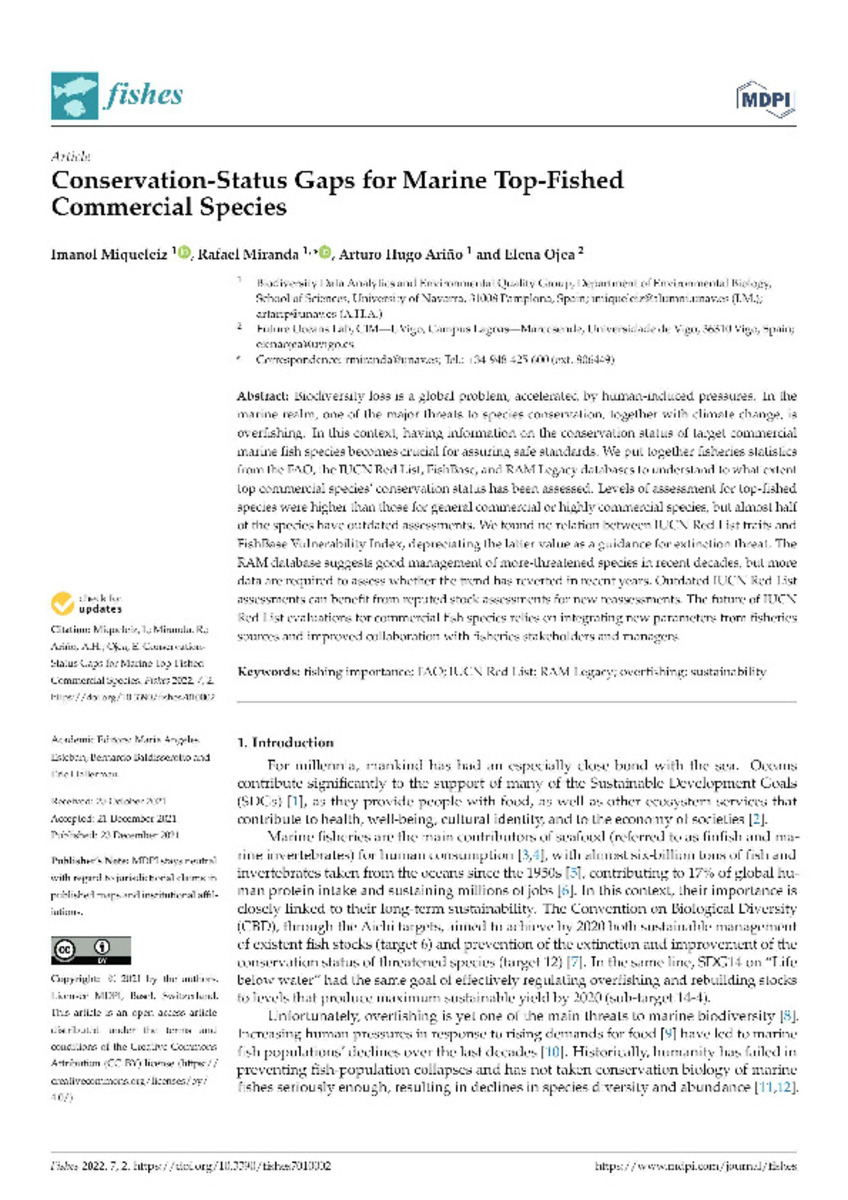Full metadata record
| DC Field | Value | Language |
|---|---|---|
| dc.creator | Miqueleiz-Legaz, I. (Imanol) | - |
| dc.creator | Miranda-Ferreiro, R. (Rafael) | - |
| dc.creator | Ariño-Plana, A.H. (Arturo Hugo) | - |
| dc.creator | Ojea, E. (Elena) | - |
| dc.date.accessioned | 2022-02-15T11:21:06Z | - |
| dc.date.available | 2022-02-15T11:21:06Z | - |
| dc.date.issued | 2022 | - |
| dc.identifier.citation | Miqueleiz-Legaz, I. (Imanol); Miranda-Ferreiro, R. (Rafael); Ariño-Plana, A. (Arturo Hugo); et al. "Conservation-status gaps for marine top-fished commercial species". Fishes. 7 (1), 2022, 2 | es |
| dc.identifier.issn | 2410-3888 | - |
| dc.identifier.uri | https://hdl.handle.net/10171/62918 | - |
| dc.description.abstract | Biodiversity loss is a global problem, accelerated by human-induced pressures. In the marine realm, one of the major threats to species conservation, together with climate change, is overfishing. In this context, having information on the conservation status of target commercial marine fish species becomes crucial for assuring safe standards. We put together fisheries statistics from the FAO, the IUCN Red List, FishBase, and RAM Legacy databases to understand to what extent top commercial species¿ conservation status has been assessed. Levels of assessment for top-fished species were higher than those for general commercial or highly commercial species, but almost half of the species have outdated assessments. We found no relation between IUCN Red List traits and FishBase Vulnerability Index, depreciating the latter value as a guidance for extinction threat. The RAM database suggests good management of more-threatened species in recent decades, but more data are required to assess whether the trend has reverted in recent years. Outdated IUCN Red List assessments can benefit from reputed stock assessments for new reassessments. The future of IUCN Red List evaluations for commercial fish species relies on integrating new parameters from fisheries sources and improved collaboration with fisheries stakeholders and managers. | - |
| dc.description.sponsorship | I.M. was funded by the Associati on of Friend s of the Univ ers ity of N avarra. E.O. ackn owl - edges financia! s upp ort from the Europ ean Research Council through the project CLOCK ("Climate Adap tation to Shifting Stocks"; ERC Starting Grant Agreement n8679812; EU Horizon 2020), and the GA IN Oportuniu s p rogr am , Xunta de Galicia. | - |
| dc.language.iso | en | - |
| dc.relation | info:eu-repo/grantAgreement/EC/H2020/679812/EU | - |
| dc.rights | info:eu-repo/semantics/openAccess | - |
| dc.subject | Fishing importance | - |
| dc.subject | FAO | - |
| dc.subject | IUCN Red List | - |
| dc.subject | RAM Legacy | - |
| dc.subject | Overfishing | - |
| dc.subject | Sustainability | - |
| dc.title | Conservation-status gaps for marine top-fished commercial species | - |
| dc.type | info:eu-repo/semantics/article | - |
| dc.description.note | This article is an open access article distributed under the terms and conditions of the Creative Commons Attribution (CC BY) license (https:/ / creativecommons.org / licenses / by / 4.01). | - |
| dc.identifier.doi | 10.3390/fishes7010002 | - |
| dadun.citation.number | 1 | - |
| dadun.citation.publicationName | Fishes | - |
| dadun.citation.startingPage | 2 | - |
| dadun.citation.volume | 7 | - |
Files in This Item:
Statistics and impact
Items in Dadun are protected by copyright, with all rights reserved, unless otherwise indicated.






